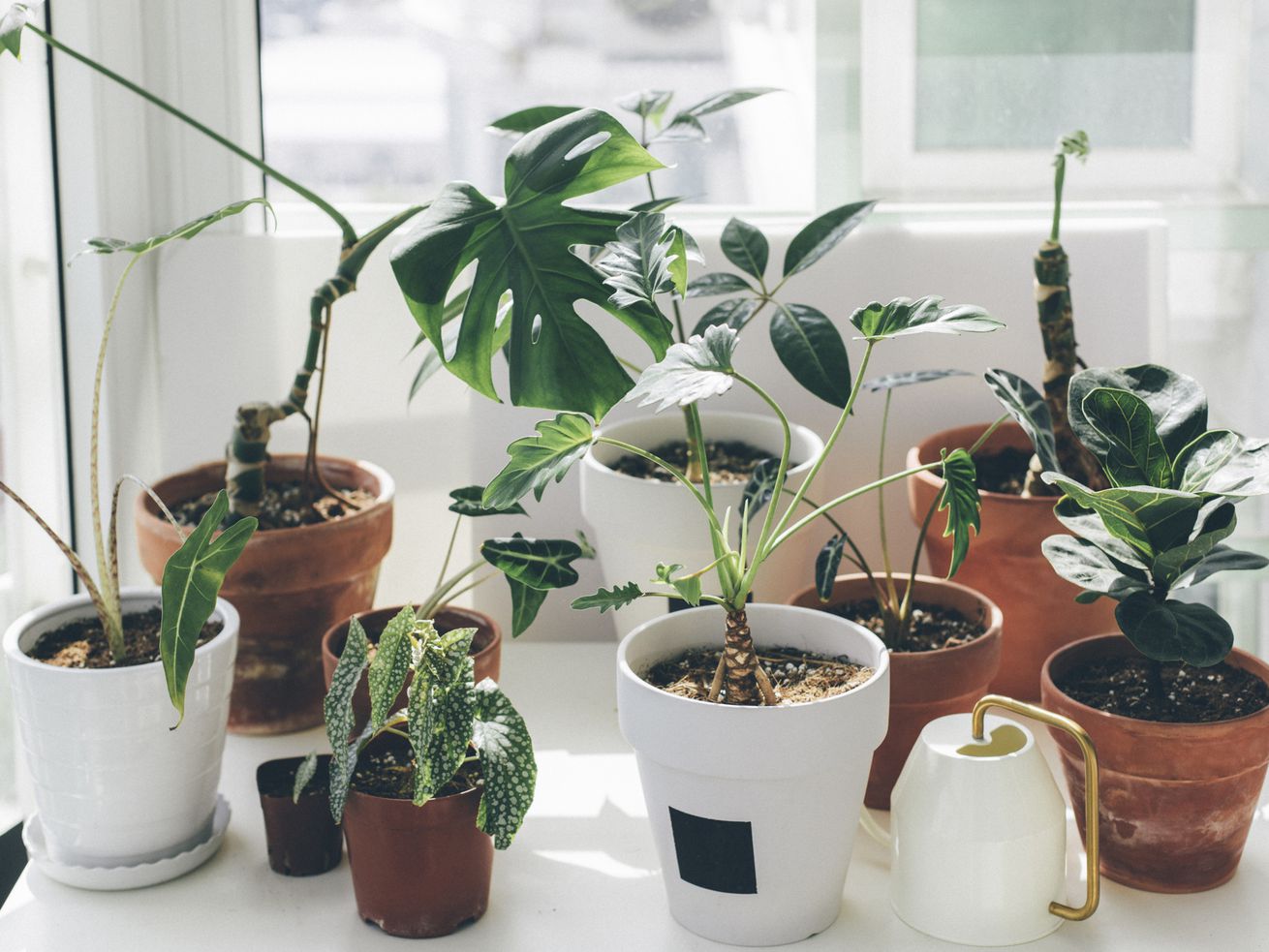The explosion in plant demand has led to a massive industry whose environmental effects can be tricky to nail down.
In early January 2021, Nick Pileggi sat in front of a video camera, a wall of greenery behind him.
“It’s no secret that houseplants have become very trendy as of last year, 2020, around the beginning of the coronavirus pandemic,” he begins, referring to a surge in demand spurred in part by the lockdown-induced solitude of spending so much time indoors.
The YouTuber has amassed a modest but loyal following of 135,000 by sharing watering how-tos, plant unboxing videos, and tours of his personal 350-plus plant collection. In this particular video, he’s discussing houseplant trends that are already over.
“Let’s go ahead and get started,” Pileggi says, picking up a glazed terra cotta pot and launching into a list of once-trendy-but-now-overdone plant species.
Pileggi is one of many micro-influencers who have tapped into the houseplant boom of the last few years. A rising number of internet personalities have turned owning massive plant collections into a lucrative personal brand, and the pandemic has only heightened this reality. While the shared desire to bring greenery into our homes initially stemmed from a reaction to climate anxiety and rising urbanism, Covid-19 intensified these emotions and multiplied them with the twin desires to have something to care for, to fill long hours at home by bringing the great outdoors in.
Much of this trend was fueled by social media. According to analytics from social media management firm Sprout Social, plants were mentioned on Instagram an average of more than 3,000 times a day in July. The hashtag #plantmom has been used more than 2.6 million times on the social media site, by both everyday plant owners and influencers serving up growing guides and house tours. Meanwhile, its gender-neutral counterpart, #plantparenthood, has been used more than 1.3 million times. Over on TikTok, #plantsoftiktok has accumulated 3.4 billion views on the video-sharing platform.
As with any social media trend, the rise in plant ownership sparked a newfound demand for the industry as a whole: The sector grew by 50 percent ($1.7 billion) between 2016 and 2019, per the National Gardening Association’s annual survey, but that growth has accelerated over the course of the pandemic. According to Greenhouse Management magazine’s 2020 State of the Industry report, 71 percent of North American greenhouses saw an increase in plant sales in 2020, and 67 percent felt confident this trend would continue throughout this year. The 2019 National Gardening Survey also found that 18- to 34-year-olds have been a dominant source of sales in recent years.
Behind this market growth are a handful of industrial farms that increasingly rely upon automation, deploy large volumes of water, use massive swaths of land, and control growth via strict heat and lighting conditions to cultivate enough crops to meet consumer needs.
Those key industrial greenhouses occupy a large share of the market, and, as such, have substantial control over its movement. The clearest example of this, Pileggi says in his video, is in the case of the Pilea peperomioides, commonly known as the Chinese money plant — or, as he calls it (using scare quotes and rolling his eyes), “the OG ‘it’ plant of the new wave of houseplant enthusiasts.” An extremely rare find in the US as recently as 2016–2017, the plant has skyrocketed in both supply and demand. With its signature circular leaves, symmetrical growing pattern, and spindly stems, it was largely considered one of the most visually satisfying, Instagrammable houseplants out there just a couple of years ago. Its success was fueled by a combination of the sense of scarcity cultivated by social media and the plant’s own hardiness, The Goods wrote in 2019.
It was once impossible to get a Pilea for less than $50, Pileggi says. Now they’re in every greenhouse, sell for $5 to $10 a pop, and are “the ‘it’ plant of yesteryear,” the YouTuber notes.
Large-scale farming practices have helped make it possible for plants like the Pilea to go from relative rarities to household staples within a matter of a few years. The plant, which is native to southern China, wasn’t commercially popular in Western markets until the 2010s. Today, it’s grown by the acre at large-scale houseplant farms and greenhouses operated by multinational, multimillion-dollar corporations like Costa Farms, which calls it the Pilea Sharing Plant, a name it trademarked. Across its growing facilities in Florida, North and South Carolina, China, and the Dominican Republic, Costa Farms harvests plants like the Pilea in thick, tidy rows, before sending them on long-haul trucks across the country to be sold on Amazon and in Home Depot, Costco, Marshalls, Trader Joes, and dozens more retailers. It harvests more than 1,500 varieties of plants, supplying rapidly growing demand for indoor greenery and driving down prices along the way.
“They have a very complex shipping structure and inventory structure to make sure that they’re keeping up with demand,” Kate Spirgen, editor of Garden Center, Greenhouse Management, and Produce Grower magazines, said of Costa Farms. “That’s kind of an anomaly.”
“I saw a piece … a couple of weeks ago where a guy said, ‘Whenever Costa Farms gets anything, we have to stop growing it,’” says Justin Hancock, brand marketing manager at Costa Farms. Hancock notes that the perception of Costa’s influence on prices is somewhat “exaggerated,” but acknowledges the sentiment is mostly correct: The houseplant producer can propagate at such a scale that it’s difficult for smaller greenhouses to compete and turn a profit.
To grow foliage at such a scale, Costa Farms uses 4,000 acres of land, around the size of 3,025 football fields. The company takes pride in its plants’ genetics, modifying its varieties — like the popular “Neon” pothos, notable for its streaks of electric chartreuse on each heart-shaped leaf — and maintaining a trial garden where it experiments with new breeds and “irradiates cuttings to force a genetic mutation out of them,” Hancock says.
“We know that superior genetics produce superior plants,” the company says on its website. “By raising our own plants, we control all our own genetics.”
According to estimates from financial analytics firm Dun & Bradstreet, Costa Farms LLC reeled in $865 million in revenue in 2020. It holds a firm grasp over the movement of the market, Pileggi says: Plants that make it onto Costa’s “Trending Tropicals” list often peak in popularity soon thereafter, becoming widely available and affordable before losing their spot to a more exclusive variety. They’re typically selected by a Costa Farms “plant hunter,” who tours labs and grow houses worldwide every year to identify new plants worth propagating en masse. From there, the role of the Trending Tropicals list is to both sway and affirm consumer sentiment, Hancock says: “Those are plants that we’ve either identified as starting to trend, or that we feel have a lot of potential to become trendy, and consumers just may not know about them yet.”
Take the variegated Monstera adansonii (also called the Swiss cheese plant), for example: A popular member of the arum family, Araceae, and native to tropical rainforests, the Swiss cheese plant currently sits on the Trending Tropicals list, lauded for its “striking and trendy” pointed leaves. The strain has previously sparked online bidding wars, at one point selling for $5,000. As of this writing, you can find the plant on Etsy in a 4-inch pot for $14.39.
This is by design, Hancock says, describing Costa Farms’ plant-hunting process: “There might be only five of this plant in existence right now, so [our plant hunter will] buy them, have them imported to the United States, and then it’s the long process of testing. One cutting makes two, two cuttings make four, four cuttings make 16, slowly getting up to the tens of thousands that we would need to distribute across the United States and Canada.”
At the North Carolina farm of competing greenhouse Metrolina, annuals and perennials, poinsettias and mums, foliage and succulents sit in smooth rows a few meters wide — easily mistaken for an arrangement of Astroturf or a cluster of football fields from a bird’s-eye view.
Inside the company’s heated, 162-acre greenhouse — which Metrolina says is the largest in the country — an industrial seeder swings above small pots of soil arranged in pallet-sized batches. The device plops down, inserts 100 or so seedlings into the same number of palm-sized black pots, and then lifts up, moving a few feet over to repeat the process. The plants are picked up and moved around the greenhouse by small, automated forklifts that look like they belong in Star Wars. Rows upon rows of plants are watered overhead by an industrial mister that glides along a rig attached to the ceiling, doling out just the right number of carefully programmed droplets — a total of 1.5 million gallons each day.
This is houseplant cultivation on steroids, with nearly every step of the process automated for maximum efficiency and output. (Metrolina isn’t shy about sharing these practices in its promotional materials, despite the publicity that surrounded the 2009 death of founder Tom van Wingerden in a machinery accident inside its facilities.)
Practices like Metrolina’s are likely to become more commonplace with time: Of the 200 greenhouses surveyed by Greenhouse Management for its 2020 State of the Industry report, 49 percent plan to invest in automation in the coming year to cut down on labor costs amid surging demand, sparked in part by social media. That’s up from 40 percent in the 2019 report.
“People get really excited about posting their new plants, and it’s become a lot more mainstream,” Spirgen says. “I think the biggest driver [of industry growth] has been social media, and people just getting really excited to brag and show off their plants.”
Perhaps understanding today’s houseplant boom requires looking to the last one, University of Georgia Extension horticulturist Bodie Pennisi told the Associated Press in 2018. In the 1970s, she said, the Green Revolution — a rapid expansion in agricultural food production spurred by the use of fertilizers, pesticides, and irrigation techniques that improved overall efficiency — led to a similar rise in the availability and subsequent popularity of indoor plants.
It didn’t take long for these practices to garner mainstream criticism for their environmental impact. Pesticides and fertilizers leach into nearby soil and waterways, potentially raising toxicity levels and contributing to environmentally harmful algae blooms. (Agricultural production accounts for approximately 52 percent of the US land base, according to the USDA; agriculture and forestry combined were responsible for roughly 10.5 percent of the country’s greenhouse gas emissions in 2018.) While the exact impact of houseplant farming isn’t understood as well as that of industrial agriculture, its practices paint a picture that isn’t too far off.
Seedlings grow under strictly regulated light, temperature, and humidity conditions and are doused and irrigated with large batches of water. Their growth requires a substantial amount of land that might otherwise be home to trees and natural carbon sinks. And that’s not to mention the material requirements: Metrolina uses 12 tractor-trailer loads of peat moss each week, on top of the biomass fuel required to generate the 2 billion BTUs of heat it uses to keep its greenhouse going. This impact is likely curbed in part by plants’ ability to sequester greenhouse gases, and research shows soil and fertilizer conditions can also be used to maximize how much carbon industrial horticulture sinks, as a whole.
Public grasp of the ecological impact of the latest houseplant boom remains relatively piecemeal. (The Goods reached out to Metrolina several times to inquire about its environmental footprint, but the company did not reply.) Studies on nursery farming offer evidence that the current upswing won’t come without a substantial carbon footprint.
In 2019, the University of Kentucky’s Dewayne Ingram co-authored a paper on the large-scale production of poinsettias, the sales of which totaled $153 million in 2019. He found each unit to have a carbon footprint of 0.474 kilograms, made up of contributions from irrigation, gas- and electric-powered watering systems, fertilization, and plastic from storage pots. (As a point of comparison, burning a liter of gasoline produces just over 2 kilograms of CO2).
Embracing green practices could look like several things, the researchers wrote — using space and energy more efficiently, recycling water, and misting sparingly are a start, and reusing materials like seedling holders also helps, Spirgen says.
“A lot of producers recycle that [plastic]. A lot of them don’t,” she says. “It really depends on the individual operation there.”
Costa Farms’s Hancock notes that factors such as plastic and pesticide use are of constant concern, though warm, humid weather conditions in its southerly growing stations allow the company to cut down on the energy and water needed to recreate these conditions artificially. The company is also aiming to replace many of its chemicals with biological controls like beneficial insects and fungi.
Transport from seedling to store shelf should also be accounted for in estimates of the environmental impact of this booming industry. Recently, concern over the eco footprint of indoor houseplants gave way to the concept of “plant miles,” a metric used to describe how far a plant must travel to reach its point of sale. Shopping for native plants, some argue, can help cut down on the footprint that comes with nurturing a horticultural habit. Growing new plants from cuttings of old plant stems accomplishes the same thing, and raising them with compost can eliminate the need for harsh, mass-produced soils.
Still, the incentives for buying environmentally friendly varieties, like natives, are low when large-scale producers make it so easy to get greenery online quickly and affordably. It’s not just the Costas and the Metrolinas of the houseplant market that are responsible for this: Many Greenhouse Management survey respondents report pivoting to meet spikes in smaller mail-order and direct-to-consumer sales during the pandemic. Other producers saw an influx of new buyers in 2020, likely derived from a crop of the cooped-up and curious. Profit margins hit above 10 percent for around 50 percent of respondents; almost one-fifth said they fell above 20 percent.
“Sales [in 2020] were unlike anything I have seen, and it didn’t stop,” one grower said.
“Predictability of the future cycles is unattainable,” another noted. “It seems it is a big guessing game.”
In an industry rife with uncertainty, those eager to venture a guess at what’s to come may look to Costa Farms’ current Trending Tropicals list. On the docket are colorful varieties, like the Aglaonema, with its characteristic cranberry-stained leaves; the Begonia maculata, with white polka dots and rusty undersides, or the Tradescantia fluminensis, with streaks of magenta that glow in sunlight. These varieties have already begun to seep through social media, accumulating thousands of Instagram posts made by budding plant parents finding a sense of calm in caring for wildlife while so much else remains seemingly out of our control.
If the current list of Trending Tropicals is any indication, the future of household foliage could look red, purple, or even pink. It might not look very green.
Author: Audrey Carleton
Read More



